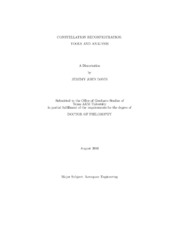| dc.description.abstract | Constellation reconfi guration consists of transforming an initial constellation
of satellites into some final constellation of satellites to maintain system optimality.
Constellations with phased deployment, changing mission requirements, or satellite
failures would all benefi t from reconfi guration capability. The constellation reconfiguration problem can be broken into two broad sub-problems: constellation design
and constellation transfer. Both are complicated and combinatorial in nature and
require new, more efficient methods. Having reviewed existing constellation design
frameworks, a new framework, the Elliptical Flower Constellations (EFCs), has been
developed that offers improved performance over traditional methods. To assist in
rapidly analyzing constellation designs, a new method for orbit propagation based
on a sequential solution of Kepler's equation is presented. The constellation transfer
problem requires an optimal assignment of satellites in the initial orbit to slots in
the final orbit based on optimal orbit transfers between them. A new method for
approximately solving the optimal two-impulse orbit transfer with fixed end-points,
the so-called minimum Delta v Lambert's problem, is developed that requires the solution
of a 4th order polynomial, as opposed to the 6th or higher order polynomials or
iterative techniques of existing methods. The recently developed Learning Approach
to sampling optimization is applied to the particular problem of general orbit transfer between two generic orbits, with several enhancements specifi c to this problem that
improve its performance. The constellation transfer problem is then posed as a Linear
Assignment Problem and solved using the auction algorithm once the orbit transfers
have been computed. Constellations designed for global navigation satellite systems
and for global communications demonstrate signifi cant improvements through the use
of the EFC framework over existing methods. An end-to-end example of constellation
recon figuration for a constellation with changing regional coverage requirements
shows the effectiveness of the constellation transfer methods. | en |


